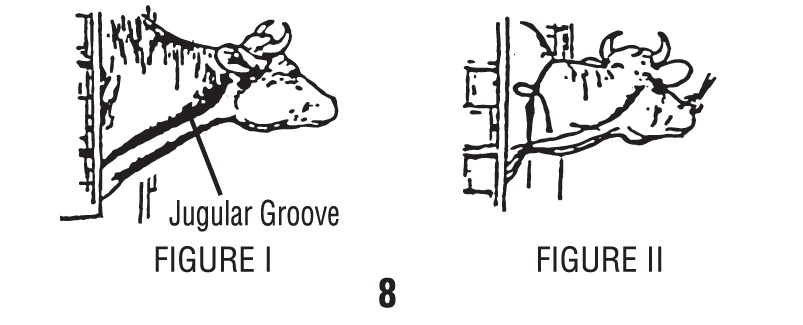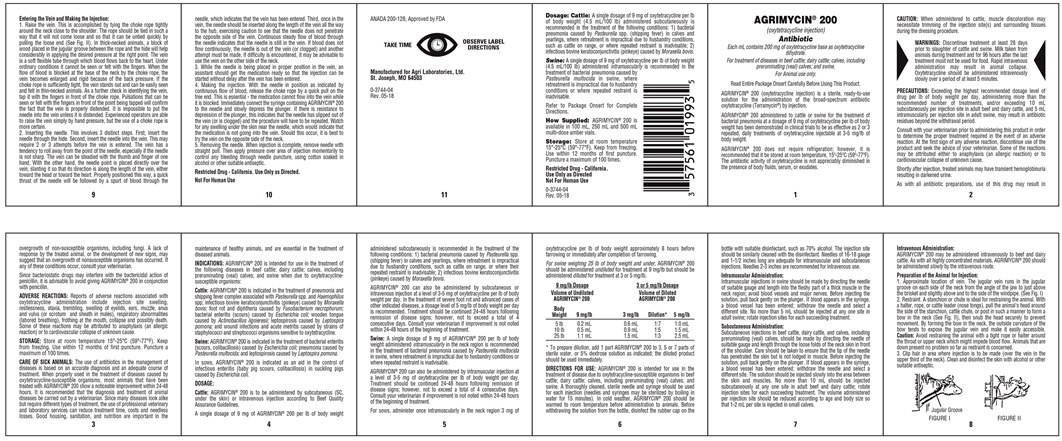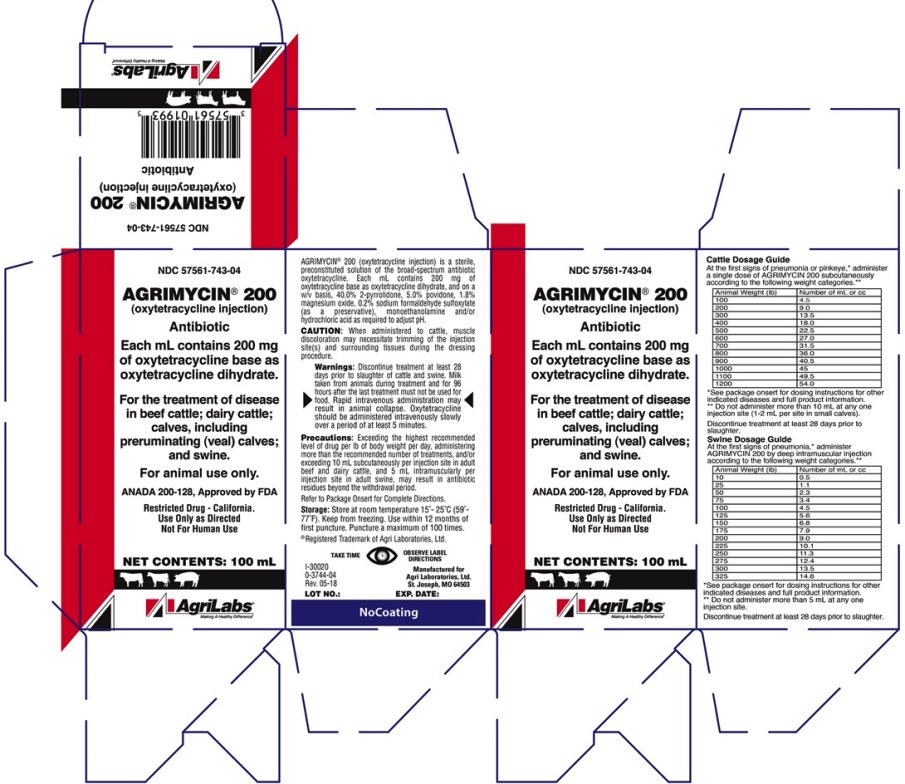AGRIMYCIN 200- oxytetracycline injection
AGRIMYCIN by
Drug Labeling and Warnings
AGRIMYCIN by is a Animal medication manufactured, distributed, or labeled by Agri Laboratories, Ltd.. Drug facts, warnings, and ingredients follow.
Drug Details [pdf]
-
DESCRIPTION
(oxytetracycline injection)
Antibiotic
Each mL contains 200 mg of oxytetracycline base as oxytetracycline dihydrate.
For treatment of diseases in beef cattle; dairy cattle; calves, including preruminating (veal) calves; and swine.
For Animal use only.
ANADA 200-128, Approved by FDA
Restricted Drug - California. Use Only as Directed.
Not for Human Use.
Read entire Package Onsert Carefully Before Using This Product.
AGRIMYCIN 200 (oxytetracycline injection) is a sterile, ready-to-use solution for the administration of the broad-spectrum antibiotic oxytetracycline (Terramycin) by injection.
AGRIMYCIN 200 administered to cattle or swine for the treatment of bacterial pneumonia at a dosage of 9 mg of oxytetracycline per lb of body weight has been demonstrated in clinical trials to be as effective as 2 or 3 repeated, daily treatments of oxytetracycline injectable at 3-5 mg/lb of body weight.
AGRIMYCIN 200 does not require refrigeration; however, it is recommended that it be stored at room temperature, 15o-25oC (59o-77oF). The antibiotic activity of oxytetracycline is not appreciably diminished in the presence of body fluids; serum, or exudates.
-
WARNINGS AND PRECAUTIONS
CAUTION: When administered to cattle, muscle discoloration may necessitate trimming of the injection site(s) and surrounding tissues during the dressing procedure.
WARNINGS: Discontinue treatment at least 28 days prior to slaughter of cattle and swine. Milk taken from animals during treatment and for 96 hours after the last treatment must not be used for food. Rapid intravenous administration may result in animal collapse. Oxytetracycline should be administered intravenously slowly over a period of at least 5 minutes.
PRECAUTIONS: Exceeding the highest recommended dosage level of drug per lb of body weight per day, administering more than the recommended number of treatments, and/or exceeding 10 mL subcutaneously per injection site in adult beef and dairy cattle, and 5 mL intramuscularly per injection site in adult swine, may result in antibiotic residues beyond the withdrawal period.
Consult with your veterinarian prior to administering this product in order to determine the proper treatment required in the event of an adverse reaction. At the first sign of any adverse reaction, discontinue use of the product and seek the advice of your veterinarian. Some of the reactions may be attributed either to anaphylaxis (an allergic reaction) or to cardiovascular collapse of unknown cause.
Shortly after injection, treated animals may have transient hemoglobinuria resulting in darkened urine.
As with all antibiotic preparations, use of this drug may result in overgrowth on non-susceptible organisms, including fungi. A lack of response by the treated animal, or the development of new signs, may suggest that an overgrowth of nonsusceptible organisms has occurred. If any of these conditions occur, consult your veterinarian.
Since bacteriostatic drugs may interfere with the bactericidal action of penicillin, it is advisable to avoid giving AGRIMYCIN 200 in conjunction with penicillin.
-
ADVERSE REACTIONS
Reports of adverse reactions associated with oxytetracycline administration include injection site swelling, restlessness, ataxia, trembling, swelling of eyelids, ears, muzzle, anus and vulva (or scrotum and sheath in males), respiratory abnormalities (labored breathing), frothing at the mouth, collapse and possibly death. Some of these reactions may be attributed to anaphylaxis (an allergic reaction) due to cardiovascular collapse of unknown cause.
- STORAGE
-
CARE OF SICK ANIMALS
The use of antibiotics in the management of diseases is based on an accurate diagnosis and an adequate course of treatment. When properly used in the treatment of diseases caused by oxytetracycline-susceptible organisms, most animals that have been treated with AGRIMYCIN 200 show a noticeable improvement within 24-48 hours. It is recommended that the diagnosis and treatment of animal diseases be carried out by a veterinarian. Since many diseases look alike but require different types of treatment, the use of professional veterinary and laboratory services can reduce treatment time, costs and needless losses. Good housing, sanitation, and nutrition are important in the maintenance of healthy animals, and are essential in the treatment of diseased animals.
-
INDICATIONS
AGRIMYCIN 200 is intended for use in the treatment of the following diseases in beef cattle; calves, including preruminating (veal) calves; and swine when due to oxytetracycline-susceptible organisms:
Cattle: AGRIMYCIN 200 is indicated in the treatment of pneumonia and shipping fever complex associated with Pasteurella spp. and Haemophilus spp; infectious bovine keratoconjunctivitis (pinkeye) caused by Moraxella bovis; foot rot and diphtheria caused by Fusobaterium necrophorum; bacterial enteritis (scours) caused by Escherichia coli; wooden tongue caused by Actinobacillus ligniereslii; leptospirosis caused by Leptospira pomona; and wound infections and acute metritis caused by strains of staphylococci and streptococci organisms sensitive to oxytetracycline.
Swine: AGRIMYCIN 200 is indicated in the treatment of bacterial enteritis (scours, colibacillosis) caused by Escherichia coli; pneumonia caused by Pasteurella multocida; and leptospirosis caused by Leptospira pomona.
In sows, AGRIMYCIN 200 is indicated as an aid in the control of infectious enteritis (baby pig scours, colibacillosis) in suckling pigs caused by Escherichia coli.
-
DOSAGE
Cattle: AGRIMYCIN 200 is to be administered by subcutaneous (SC, under the skin) or intravenous injection according to Beef Quality Assurance Guidelines.
A single dosage of 9 mg of AGRIMYCIN 200 per lb of body weight administered subcutaneously is recommended in the treatment of the following conditions: 1) bacterial pneumonia caused by Pasteurella spp. (shipping fever) in calves and yearlings, where retreatment is impractical due to husbandry conditions, such as cattle on range, or where their repeated restraint is inadvisable; 2) infectious bovine keratoconjunctivitis (pinkeye) caused by Moraxella bovis.
AGRIMYCIN 200 can also be administered by subcutaneous or intravenous injection at a level of 3-5 mg of oxytetracycline per lb of body weight per day. In the treatment of sever foot rot and advanced cases of other indicated diseases, a dosage level of 5 mg/lb of body weight per day is recommended. Treatment should be continued 24-48 hours following remission of disease signs; however, not to exceed a total of 4 consecutive days. Consult your veterinarian if improvement is not noted within 24-48 hours of the beginning of treatment.
Swine: A single dosage of 9 mg of AGRIMYCIN 200 per lb of body weight administered intramuscularly in the neck region is recommended in the treatment of bacterial pneumonia caused by Pasteurella multocida in swine, where retreatment is impractical due to husbandry conditions or where repeated restraint is inadvisable.
AGRIMYCIN 200 can also be administered by intramuscular injection at a level of 3-5 mg of oxytetracycline per lb of body weight per day. Treatment should be continued 24-48 hours following remission of disease signs; however, not to exceed a total of 4 consecutive days. Consult your veterinarian if improvement is not noted within 24-48 hours of the beginning of treatment.
For sows, administer once intramuscularly in the neck region 3 mg of oxytetracycline per lb of body weight approximately 8 hours before farrowing or immediately after completion of farrowing.
For swine weighing 25 lb of body weight and under, AGRIMYCIN 200 should be administered undiluted for treatment at 9 mg/lb but should be administered diluted for treatment at 3 or 5 mg/lb.

To prepare dilution, add 1 part AGRIMYCIN 200 to 3, 5, or 7 parts of sterile water, or 5% dextrose solution as indicated; the diluted product should be used immediately.

-
DIRECTIONS FOR USE
AGRIMYCIN 200 is intended for use in the treatment of disease due to oxytetracycline-susceptible organisms in beef cattle; dairy cattle; calves, including preruminating (veal) calves; and swine. A thoroughly cleaned, sterile needle and syringe should be used for each injection (needles and syringes may be sterilized by boiling in water for 15 minutes). In cold weather, AGRIMYCIN 200 should be warmed to room temperature before administration to animals. Before withdrawing the solution from the bottle, disinfect the rubber cap on the bottle with suitable disinfectant, such as 70% alcohol. The injection site should be similarly cleaned with the disinfectant. Needles of 16-18 gauge and 1-1/2 inches long are adequate for intramuscular and subcutaneous injections. Needles 2-3 inches are recommended for intravenous use.
Intramuscular Administration:
Intramuscular injections in swine should be made by directing the needle of suitable gauge and length into the fleshy part of a thick muscle in the neck region; avoid blood vessels and major nerves. Before injecting the solution, pull back gently on the plunger. If blood appears in the syringe, a blood vessel has been entered; withdraw the needle and select a different site. No more than 5 mL should be injected at any one site in adult swine; rotate injection sties for each succeeding treatment.
Subcutaneous Administration:
Subcutaneous injections in beef cattle, dairy cattle, and calves, including preruminating (veal) calves, should be made by directing the needle of suitable gauge and length through the loose folds of the neck skin in front of the shoulder. Care should be taken to ensure that the tip of the needle has penetrated the skin but is not lodged in muscle. Before injecting the solution, pull back gently on the plunger. If blood appears in the syringe, a blood vessel has been entered; withdraw the needle and select a different site. The solution should be injected slowly into the area between the skin and muscles. No more than 10 mL should be injected subcutaneously at any one site in adult beef and dairy cattle; rotate injection sites for each succeeding treatment. The volume administered per injection site should be reduced according to age and body size so that 1-2 mL per site is injected in small calves.
Intravenous Administration
AGRIMYCIN 200 may be administered intravenously to beef and dairy cattle. As with all highly concentrated materials, AGRIMYCIN 200 should be administered slowly by the intravenous route.
Preparation of the Animal for Injection
1. Approximate location of vein. The jugular vein runs in the jugular groove on each side of the neck from the angle of the jaw to just above the brisket and slightly above and to the side of the windpipe. (See Fig. I)
2. Restraint. A stanchion or chute is ideal for restraining the animal. With a halter, rope, or cattle leader (nose tongs), pull the animal's head around the side of the stanchion, cattle chute, or post in such a manner to form a bow in the neck (See Fig. II), then snub the head securely to prevent movement. By forming the bow in the neck, the outside curvature of the bow tends to expose the jugular vein and make it easily accessible.
Caution: Avoid restraining the animal with a tight rope or halter around the throat or upper neck which might impede blood flow. Animals that are down present no problem so far as restraint is concerned.3. Clip hair in area where injection is to be made (over the vein in the upper third of the neck). Clean and disinfect the skin with alcohol or other suitable antiseptic.

Entering the Vein and making the Injections1. Raise the vein. This is accomplished by tying the choke rope tightly around the neck close to the shoulder. The rope should be tied in such a way that it will not come loose and so that it can be untied quickly by pulling the loose end (See Fig. II). In thick-necked animals, a block of wood placed in the jugular groove between the rope and the hide will help considerably in applying the desired pressure at the right point. The vein is a soft flexible tube through which blood flows back to the heart. Under ordinary conditions it cannot be seen or felt with the fingers. When the flow of blood is blocked at the base of the neck by the choke rope, the vein becomes enlarged and rigid because of the back pressure. If the choke rope is sufficiently tight, the vein stands out and can be easily seen and felt in thin-necked animals. As a further check in identifying the vein, tap it with the fingers in front of the choke rope. Pulsations that can be seen or felt with the fingers in front of the point being tapped will confirm the fact that the vein is properly distended. It is impossible to put the needle into the vein unless it is distended. Experienced operators are able to raise the vein simply by hand pressure, but the use of a choke rope is more certain.
2. Inserting the needle. This involves 3 distinct steps. First, insert the needle through the hide. Second, insert the needle into the vein. This may require 2 or 3 attempts before the vein is entered. The vein has a tendency to roll away from the point of the needle, especially if the needle is not sharp. The vein can be steadied with the thumb and finger of one hand. With the other hand, the needle point is placed directly over the vein, slanting it so that its direction is along the length of the vein, either toward the head or toward the heart. Properly positioned this way, a quick thrust of the needle will be followed by a spurt of blood through the needle, which indicates that the vein has been entered. Third, once in the vein, the needle should be inserted along the length of the vein all the way to the hub, exercising caution to see that the needle does not penetrate the opposite side of the vein. Continuous steady flow of blood through the needle indicates that the needle is still in the vein. If blood does not flow continuously, the needle is out of the vein (or clogged) and another attempt must be made. If difficulty is encountered, it may be advisable to use the vein on the other side of the neck.
3. While the needle is being placed in proper position in the vein, an assistant should get the medication ready so that the injection can be started without delay after the vein has been entered.
4. Making the injection. With the needle in position as indicated by continuous flow of blood, release the choke rope by a quick pull on the free end. This is essential - the medication cannot flow into the vein while it is blocked. Immediately connect the syringe containing AGRIMYCIN 200 to the needle and slowly depress the plunger. If there is resistance to depression of the plunger, this indicates that the needle has slipped out of the vein (or is clogged) and the procedure will have to be repeated. Watch for any swelling under the skin near the needle, which would indicate that the medication is not going into the vein. Should this occur, it is best to try the vein on the opposite side of ten neck.
5. Removing the needle. When injection is complete, remove needle with straight pull. Then apply pressure over area of injection momentarily to control any bleeding through needle puncture, using cotton soaked in alcohol or other suitable antiseptic.
-
Dosage
Cattle: A single dosage of 9 mg of oxytetracycline per lb of body weight (4.5 mL/100 lb) administered subcutaneously is recommended in the treatment of the following conditions: 1) bacterial pneumonia caused by Pasteurella spp. (shipping fever) in calves and yearlings, where retreatment is impractical due to husbandry conditions, such as cattle on range, or where repeated restraint is inadvisable; 2) infectious bovine keratoconjunctivitis (pinkeye) caused by Moraxella bovis.
Swine: A single dosage of 9 mg of oxytetracycline per lb of body weight (4.5 mL/100 lb) administered intramuscularly is recommended in the treatment of bacterial pneumonia caused by pasterurella multocida in swine, where repeated restraint is inadvisable.
Refer to package Onsert for Complete Directions.
- How Supplied
- PRINCIPAL DISPLAY PANEL
-
INGREDIENTS AND APPEARANCE
AGRIMYCIN 200
oxytetracycline injectionProduct Information Product Type OTC ANIMAL DRUG Item Code (Source) NDC: 57561-743 Route of Administration SUBCUTANEOUS Active Ingredient/Active Moiety Ingredient Name Basis of Strength Strength OXYTETRACYCLINE (UNII: X20I9EN955) (OXYTETRACYCLINE ANHYDROUS - UNII:SLF0D9077S) OXYTETRACYCLINE 200 mg in 1 mL Packaging # Item Code Package Description Marketing Start Date Marketing End Date 1 NDC: 57561-743-04 100 mL in 1 VIAL 2 NDC: 57561-743-05 250 mL in 1 VIAL 3 NDC: 57561-743-06 500 mL in 1 VIAL Marketing Information Marketing Category Application Number or Monograph Citation Marketing Start Date Marketing End Date ANADA ANADA200128 09/01/2016 Labeler - Agri Laboratories, Ltd. (155594450)
Trademark Results [AGRIMYCIN]
Mark Image Registration | Serial | Company Trademark Application Date |
|---|---|
 AGRIMYCIN 73725661 1542197 Live/Registered |
AGRI LABORATORIES, LTD. 1988-05-02 |
© 2025 FDA.report
This site is not affiliated with or endorsed by the FDA.


